HI5003 Economics for Business: GDP and Growth in Australia
VerifiedAdded on 2024/06/04
|11
|3163
|218
Report
AI Summary
This report provides an analysis of Australia's GDP and economic growth over the last five years. It highlights the key factors influencing the Australian economy, including the service sector's dominance, trade relationships with East Asia, and the country's significant natural resources. The report examines the GDP growth rate from 1959 to 2017, noting fluctuations and the impact of various economic activities such as household spending, government expenses, and private investments. It also discusses the influence of mining, construction, and telecommunications on the economy. Furthermore, the report touches upon the Australian government's policies, citizen freedoms, and regulations related to property ownership, emphasizing the balance between economic development and social well-being. Desklib offers this and many other solved assignments for students.

HI5003 ECONOMICS FOR BUSINESS
(GROUP ASSIGNMENT)
1
(GROUP ASSIGNMENT)
1
Paraphrase This Document
Need a fresh take? Get an instant paraphrase of this document with our AI Paraphraser
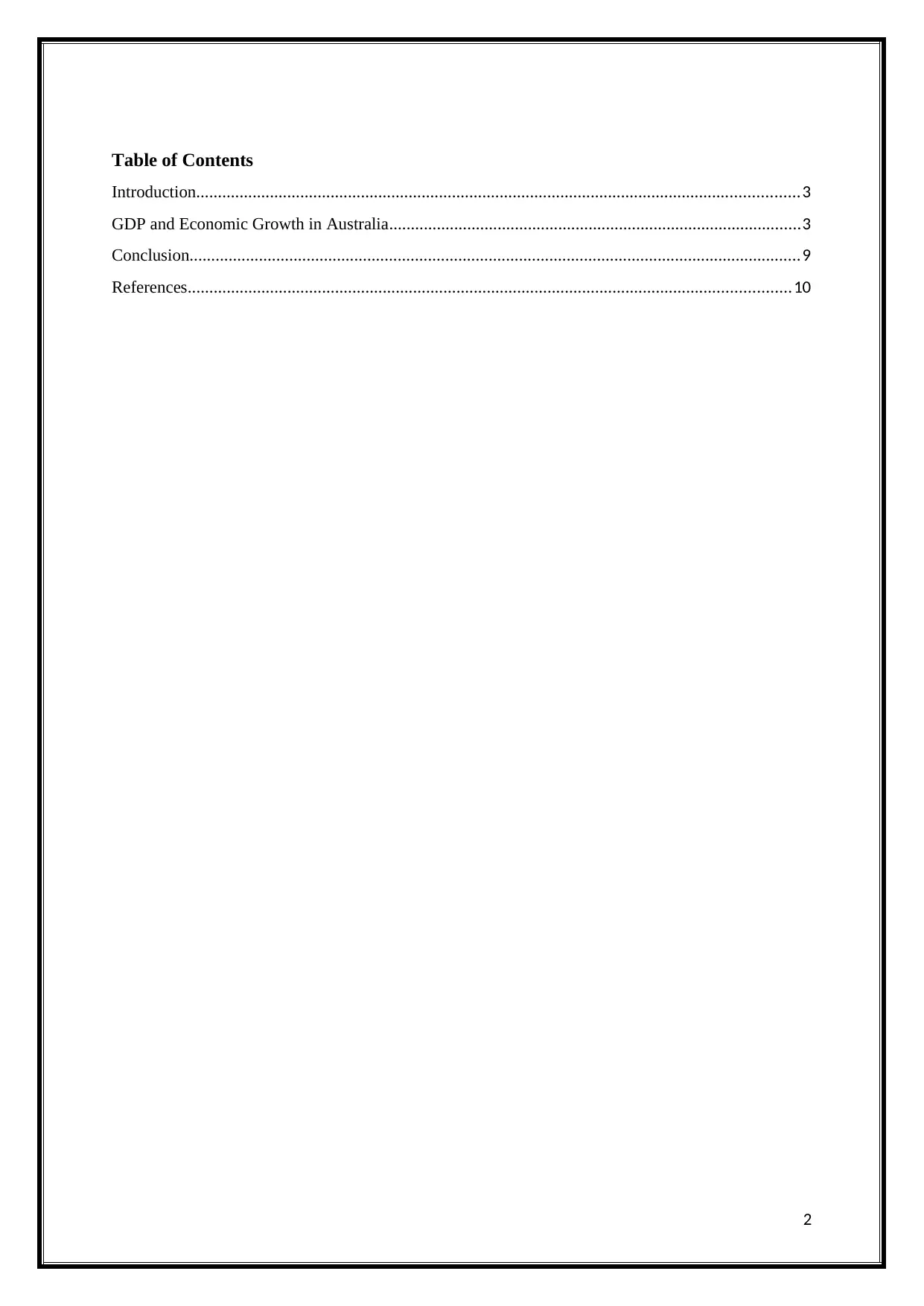
Table of Contents
Introduction...........................................................................................................................................3
GDP and Economic Growth in Australia...............................................................................................3
Conclusion.............................................................................................................................................9
References...........................................................................................................................................10
2
Introduction...........................................................................................................................................3
GDP and Economic Growth in Australia...............................................................................................3
Conclusion.............................................................................................................................................9
References...........................................................................................................................................10
2
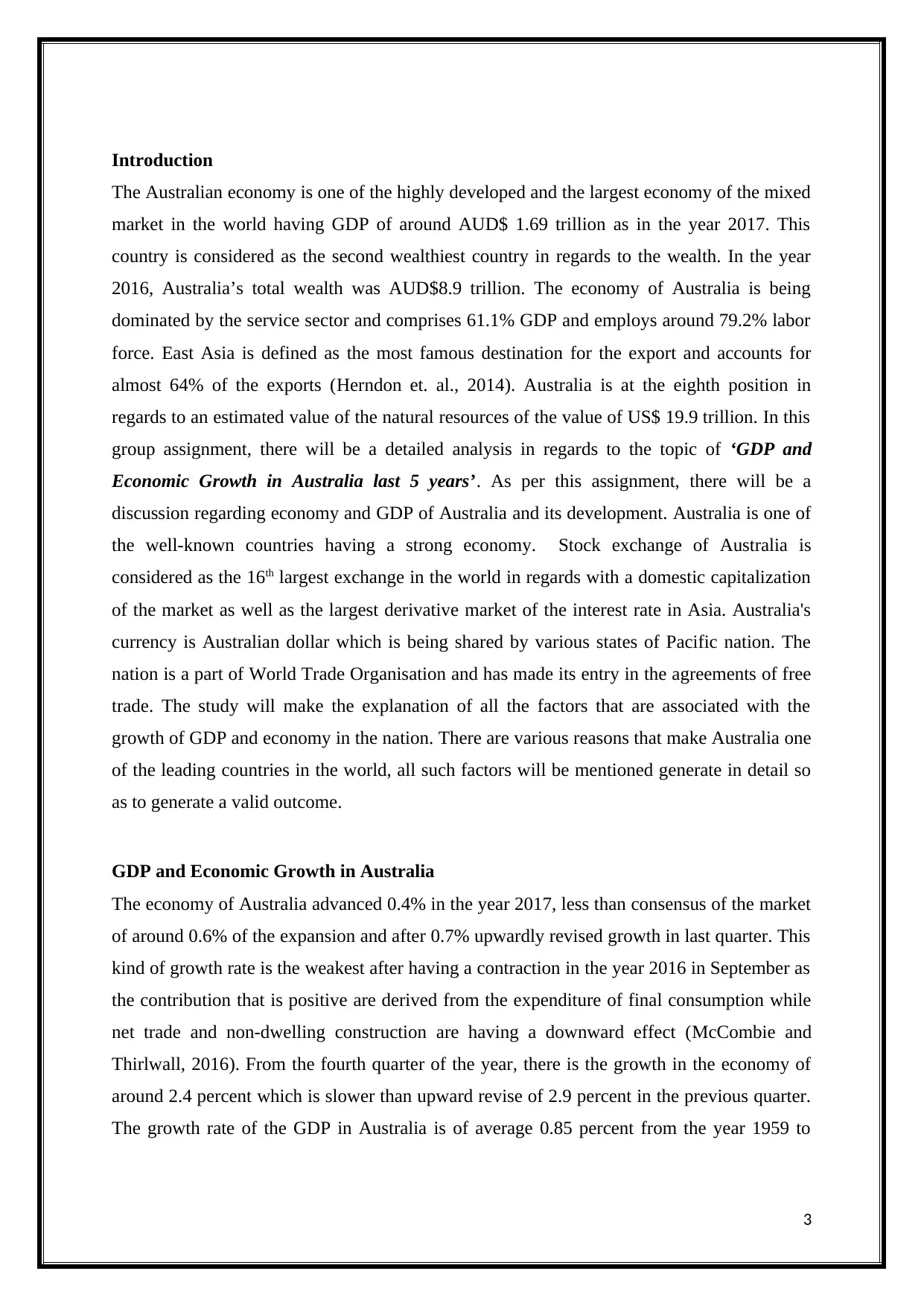
Introduction
The Australian economy is one of the highly developed and the largest economy of the mixed
market in the world having GDP of around AUD$ 1.69 trillion as in the year 2017. This
country is considered as the second wealthiest country in regards to the wealth. In the year
2016, Australia’s total wealth was AUD$8.9 trillion. The economy of Australia is being
dominated by the service sector and comprises 61.1% GDP and employs around 79.2% labor
force. East Asia is defined as the most famous destination for the export and accounts for
almost 64% of the exports (Herndon et. al., 2014). Australia is at the eighth position in
regards to an estimated value of the natural resources of the value of US$ 19.9 trillion. In this
group assignment, there will be a detailed analysis in regards to the topic of ‘GDP and
Economic Growth in Australia last 5 years’. As per this assignment, there will be a
discussion regarding economy and GDP of Australia and its development. Australia is one of
the well-known countries having a strong economy. Stock exchange of Australia is
considered as the 16th largest exchange in the world in regards with a domestic capitalization
of the market as well as the largest derivative market of the interest rate in Asia. Australia's
currency is Australian dollar which is being shared by various states of Pacific nation. The
nation is a part of World Trade Organisation and has made its entry in the agreements of free
trade. The study will make the explanation of all the factors that are associated with the
growth of GDP and economy in the nation. There are various reasons that make Australia one
of the leading countries in the world, all such factors will be mentioned generate in detail so
as to generate a valid outcome.
GDP and Economic Growth in Australia
The economy of Australia advanced 0.4% in the year 2017, less than consensus of the market
of around 0.6% of the expansion and after 0.7% upwardly revised growth in last quarter. This
kind of growth rate is the weakest after having a contraction in the year 2016 in September as
the contribution that is positive are derived from the expenditure of final consumption while
net trade and non-dwelling construction are having a downward effect (McCombie and
Thirlwall, 2016). From the fourth quarter of the year, there is the growth in the economy of
around 2.4 percent which is slower than upward revise of 2.9 percent in the previous quarter.
The growth rate of the GDP in Australia is of average 0.85 percent from the year 1959 to
3
The Australian economy is one of the highly developed and the largest economy of the mixed
market in the world having GDP of around AUD$ 1.69 trillion as in the year 2017. This
country is considered as the second wealthiest country in regards to the wealth. In the year
2016, Australia’s total wealth was AUD$8.9 trillion. The economy of Australia is being
dominated by the service sector and comprises 61.1% GDP and employs around 79.2% labor
force. East Asia is defined as the most famous destination for the export and accounts for
almost 64% of the exports (Herndon et. al., 2014). Australia is at the eighth position in
regards to an estimated value of the natural resources of the value of US$ 19.9 trillion. In this
group assignment, there will be a detailed analysis in regards to the topic of ‘GDP and
Economic Growth in Australia last 5 years’. As per this assignment, there will be a
discussion regarding economy and GDP of Australia and its development. Australia is one of
the well-known countries having a strong economy. Stock exchange of Australia is
considered as the 16th largest exchange in the world in regards with a domestic capitalization
of the market as well as the largest derivative market of the interest rate in Asia. Australia's
currency is Australian dollar which is being shared by various states of Pacific nation. The
nation is a part of World Trade Organisation and has made its entry in the agreements of free
trade. The study will make the explanation of all the factors that are associated with the
growth of GDP and economy in the nation. There are various reasons that make Australia one
of the leading countries in the world, all such factors will be mentioned generate in detail so
as to generate a valid outcome.
GDP and Economic Growth in Australia
The economy of Australia advanced 0.4% in the year 2017, less than consensus of the market
of around 0.6% of the expansion and after 0.7% upwardly revised growth in last quarter. This
kind of growth rate is the weakest after having a contraction in the year 2016 in September as
the contribution that is positive are derived from the expenditure of final consumption while
net trade and non-dwelling construction are having a downward effect (McCombie and
Thirlwall, 2016). From the fourth quarter of the year, there is the growth in the economy of
around 2.4 percent which is slower than upward revise of 2.9 percent in the previous quarter.
The growth rate of the GDP in Australia is of average 0.85 percent from the year 1959 to
3
⊘ This is a preview!⊘
Do you want full access?
Subscribe today to unlock all pages.

Trusted by 1+ million students worldwide
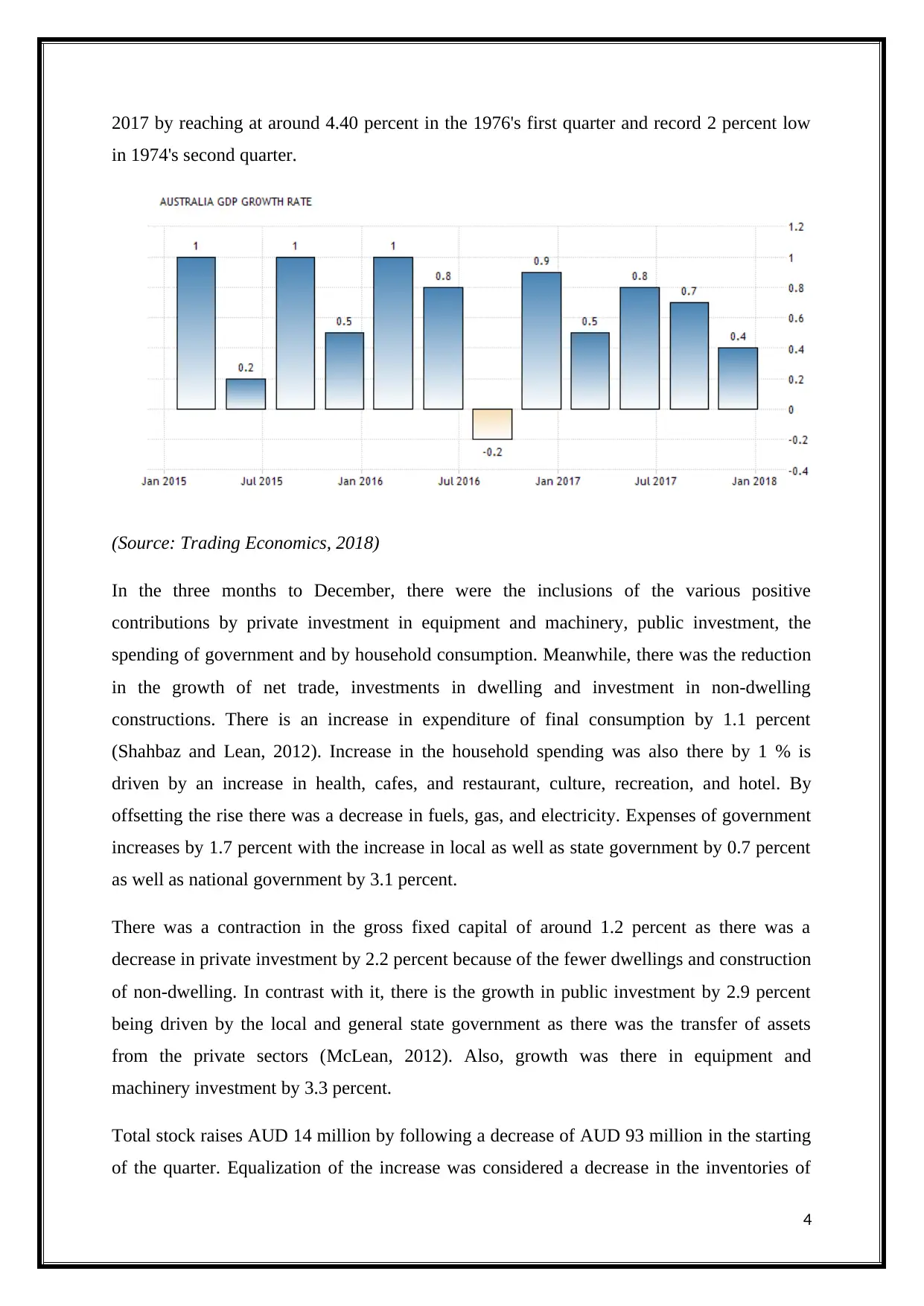
2017 by reaching at around 4.40 percent in the 1976's first quarter and record 2 percent low
in 1974's second quarter.
(Source: Trading Economics, 2018)
In the three months to December, there were the inclusions of the various positive
contributions by private investment in equipment and machinery, public investment, the
spending of government and by household consumption. Meanwhile, there was the reduction
in the growth of net trade, investments in dwelling and investment in non-dwelling
constructions. There is an increase in expenditure of final consumption by 1.1 percent
(Shahbaz and Lean, 2012). Increase in the household spending was also there by 1 % is
driven by an increase in health, cafes, and restaurant, culture, recreation, and hotel. By
offsetting the rise there was a decrease in fuels, gas, and electricity. Expenses of government
increases by 1.7 percent with the increase in local as well as state government by 0.7 percent
as well as national government by 3.1 percent.
There was a contraction in the gross fixed capital of around 1.2 percent as there was a
decrease in private investment by 2.2 percent because of the fewer dwellings and construction
of non-dwelling. In contrast with it, there is the growth in public investment by 2.9 percent
being driven by the local and general state government as there was the transfer of assets
from the private sectors (McLean, 2012). Also, growth was there in equipment and
machinery investment by 3.3 percent.
Total stock raises AUD 14 million by following a decrease of AUD 93 million in the starting
of the quarter. Equalization of the increase was considered a decrease in the inventories of
4
in 1974's second quarter.
(Source: Trading Economics, 2018)
In the three months to December, there were the inclusions of the various positive
contributions by private investment in equipment and machinery, public investment, the
spending of government and by household consumption. Meanwhile, there was the reduction
in the growth of net trade, investments in dwelling and investment in non-dwelling
constructions. There is an increase in expenditure of final consumption by 1.1 percent
(Shahbaz and Lean, 2012). Increase in the household spending was also there by 1 % is
driven by an increase in health, cafes, and restaurant, culture, recreation, and hotel. By
offsetting the rise there was a decrease in fuels, gas, and electricity. Expenses of government
increases by 1.7 percent with the increase in local as well as state government by 0.7 percent
as well as national government by 3.1 percent.
There was a contraction in the gross fixed capital of around 1.2 percent as there was a
decrease in private investment by 2.2 percent because of the fewer dwellings and construction
of non-dwelling. In contrast with it, there is the growth in public investment by 2.9 percent
being driven by the local and general state government as there was the transfer of assets
from the private sectors (McLean, 2012). Also, growth was there in equipment and
machinery investment by 3.3 percent.
Total stock raises AUD 14 million by following a decrease of AUD 93 million in the starting
of the quarter. Equalization of the increase was considered a decrease in the inventories of
4
Paraphrase This Document
Need a fresh take? Get an instant paraphrase of this document with our AI Paraphraser

retail trade and farm. 1.8 percent decrease was there in goods and services and drop of 1.7
percent was there in good's export with the decrease in non-rural exports by 0.3 percent and
rural exports by 9.7 percent. 1.9 % decrease was also there in exports of services and 0.5 %
increase in services and goods. Increase in the goods depicts rise in the intermediate goods as
well as in the consumption of goods. In Australia, mining also got increased being driven by
coal mining and iron ore mining while having a decrease in the extraction of oil and gas
(Hatfield-Dodds et. al., 2015). Day by day new building is being built up which made the
increase in the overall construction. Telecommunication, media, and information also grow
being driven by media services, telecommunication services, and some other information.
Financial as well as insurance service also increased up and results in the growth in economy
and GDP. As the rise was there in public and private health, it makes an impact on social and
healthcare assistance.
(Source: Sweet Crude, 2017)
Australia is there in the 26th consecutive year of the growth in the economy. In the year 2017-
18 growth is expected to get increased to 23/4 % after decreasing in 2016-17 due to factors
being a relation with weather and with Tropical Cyclone Debbie.
The rise in the growth of the economy, expected to get recovery over forecasting horizon.
Last year, it has been recorded by a global economy that there is a low rate of growth because
of the financial crisis but various encouraging signs are also there regarding the firming of
5
percent was there in good's export with the decrease in non-rural exports by 0.3 percent and
rural exports by 9.7 percent. 1.9 % decrease was also there in exports of services and 0.5 %
increase in services and goods. Increase in the goods depicts rise in the intermediate goods as
well as in the consumption of goods. In Australia, mining also got increased being driven by
coal mining and iron ore mining while having a decrease in the extraction of oil and gas
(Hatfield-Dodds et. al., 2015). Day by day new building is being built up which made the
increase in the overall construction. Telecommunication, media, and information also grow
being driven by media services, telecommunication services, and some other information.
Financial as well as insurance service also increased up and results in the growth in economy
and GDP. As the rise was there in public and private health, it makes an impact on social and
healthcare assistance.
(Source: Sweet Crude, 2017)
Australia is there in the 26th consecutive year of the growth in the economy. In the year 2017-
18 growth is expected to get increased to 23/4 % after decreasing in 2016-17 due to factors
being a relation with weather and with Tropical Cyclone Debbie.
The rise in the growth of the economy, expected to get recovery over forecasting horizon.
Last year, it has been recorded by a global economy that there is a low rate of growth because
of the financial crisis but various encouraging signs are also there regarding the firming of
5

outlook. In the year 2017, the entry has been made by China with good momentum and the
economies of United States are doing well. Improvement signs are also there in various
advanced economies and distinct emerging economies there is fall in the prices of a
commodity (Katz, 2012). Various major advanced are being increased above potential,
gradually decreasing rates of unemployment.
Domestically, transitions of Australia towards broader tasks are well advanced. Anticipation
has been made that; there will be an increase in the growth by analyzing weather-related
event's impact in the year 2016-2017. Real growth in the GDP is expected to be around 23/4
percent 2017-18 and around 3 percent in the year 2018-19. Economic performance of
Australia continues to be in favour with various advanced economies by involving various
exporters of the commodity.
Economic performance across the Territories and States continues to differentiate in a wide
manner. The shift's impact being away from the investment of mining and towards exports of
the resource is being considered as the most strong in Queensland and Western Australia.
Victoria and New South Wales are growing with the fast speed in comparison with averages
of the decade, being supported by low rates of interest, low rates of exchange and solid
growth of population (Checherita-Westphal and Rother, 2012).
There is the fall in the mining investments in the last three financial years and has detracted
for around 1% in a year from the growth of real GDP. In the same time, strong contribution in
the growth is made by exports of resources by having an adjustment from the phase of
investment to the phase of production. The growth drag from the investment of mining is
being expected to decrease over forecast horizon and exports or resource forecast to continue
in order maintain growth in the nation.
The provision in regards with the policy analysis is common for all government systems, but
the advisory system’s nature is highly variable and depends on various institutional as well as
political factors (Peter’s et. al., 2012). For instance, the advice's main source and their
legitimacy and influence in the system of politics will make difference according to the
nongovernmental organisation and public institutions and forums for the purpose of
democratic discussion have made evolution in various countries. The difference is also there
in historical traditions across boundaries of the nation in terms of analysts and advisors of
professional skills, as well as the use of techniques in considering options of policy. The
system of the policy, from the year 1950 makes the involvement of various stages like
6
economies of United States are doing well. Improvement signs are also there in various
advanced economies and distinct emerging economies there is fall in the prices of a
commodity (Katz, 2012). Various major advanced are being increased above potential,
gradually decreasing rates of unemployment.
Domestically, transitions of Australia towards broader tasks are well advanced. Anticipation
has been made that; there will be an increase in the growth by analyzing weather-related
event's impact in the year 2016-2017. Real growth in the GDP is expected to be around 23/4
percent 2017-18 and around 3 percent in the year 2018-19. Economic performance of
Australia continues to be in favour with various advanced economies by involving various
exporters of the commodity.
Economic performance across the Territories and States continues to differentiate in a wide
manner. The shift's impact being away from the investment of mining and towards exports of
the resource is being considered as the most strong in Queensland and Western Australia.
Victoria and New South Wales are growing with the fast speed in comparison with averages
of the decade, being supported by low rates of interest, low rates of exchange and solid
growth of population (Checherita-Westphal and Rother, 2012).
There is the fall in the mining investments in the last three financial years and has detracted
for around 1% in a year from the growth of real GDP. In the same time, strong contribution in
the growth is made by exports of resources by having an adjustment from the phase of
investment to the phase of production. The growth drag from the investment of mining is
being expected to decrease over forecast horizon and exports or resource forecast to continue
in order maintain growth in the nation.
The provision in regards with the policy analysis is common for all government systems, but
the advisory system’s nature is highly variable and depends on various institutional as well as
political factors (Peter’s et. al., 2012). For instance, the advice's main source and their
legitimacy and influence in the system of politics will make difference according to the
nongovernmental organisation and public institutions and forums for the purpose of
democratic discussion have made evolution in various countries. The difference is also there
in historical traditions across boundaries of the nation in terms of analysts and advisors of
professional skills, as well as the use of techniques in considering options of policy. The
system of the policy, from the year 1950 makes the involvement of various stages like
6
⊘ This is a preview!⊘
Do you want full access?
Subscribe today to unlock all pages.

Trusted by 1+ million students worldwide
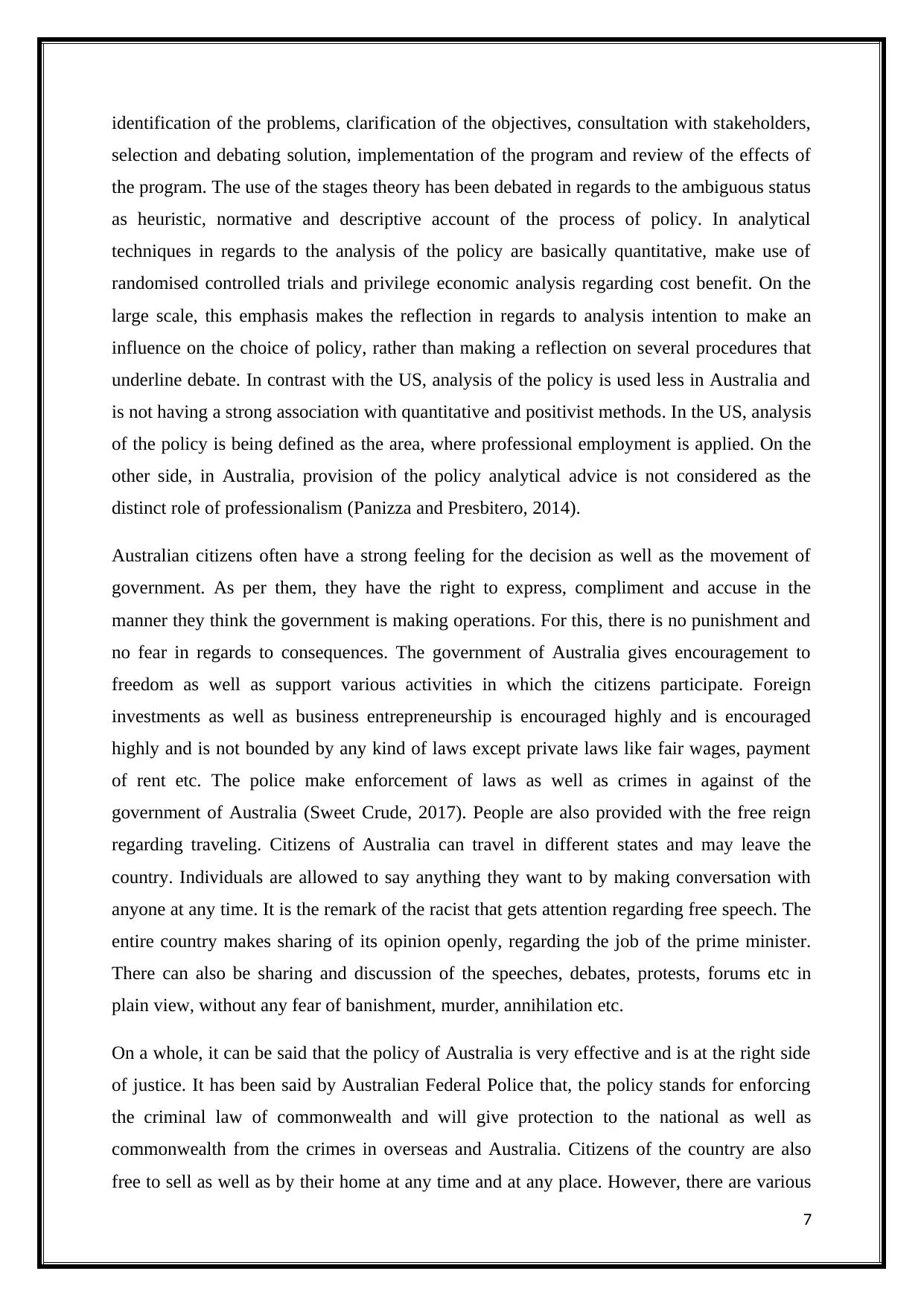
identification of the problems, clarification of the objectives, consultation with stakeholders,
selection and debating solution, implementation of the program and review of the effects of
the program. The use of the stages theory has been debated in regards to the ambiguous status
as heuristic, normative and descriptive account of the process of policy. In analytical
techniques in regards to the analysis of the policy are basically quantitative, make use of
randomised controlled trials and privilege economic analysis regarding cost benefit. On the
large scale, this emphasis makes the reflection in regards to analysis intention to make an
influence on the choice of policy, rather than making a reflection on several procedures that
underline debate. In contrast with the US, analysis of the policy is used less in Australia and
is not having a strong association with quantitative and positivist methods. In the US, analysis
of the policy is being defined as the area, where professional employment is applied. On the
other side, in Australia, provision of the policy analytical advice is not considered as the
distinct role of professionalism (Panizza and Presbitero, 2014).
Australian citizens often have a strong feeling for the decision as well as the movement of
government. As per them, they have the right to express, compliment and accuse in the
manner they think the government is making operations. For this, there is no punishment and
no fear in regards to consequences. The government of Australia gives encouragement to
freedom as well as support various activities in which the citizens participate. Foreign
investments as well as business entrepreneurship is encouraged highly and is encouraged
highly and is not bounded by any kind of laws except private laws like fair wages, payment
of rent etc. The police make enforcement of laws as well as crimes in against of the
government of Australia (Sweet Crude, 2017). People are also provided with the free reign
regarding traveling. Citizens of Australia can travel in different states and may leave the
country. Individuals are allowed to say anything they want to by making conversation with
anyone at any time. It is the remark of the racist that gets attention regarding free speech. The
entire country makes sharing of its opinion openly, regarding the job of the prime minister.
There can also be sharing and discussion of the speeches, debates, protests, forums etc in
plain view, without any fear of banishment, murder, annihilation etc.
On a whole, it can be said that the policy of Australia is very effective and is at the right side
of justice. It has been said by Australian Federal Police that, the policy stands for enforcing
the criminal law of commonwealth and will give protection to the national as well as
commonwealth from the crimes in overseas and Australia. Citizens of the country are also
free to sell as well as by their home at any time and at any place. However, there are various
7
selection and debating solution, implementation of the program and review of the effects of
the program. The use of the stages theory has been debated in regards to the ambiguous status
as heuristic, normative and descriptive account of the process of policy. In analytical
techniques in regards to the analysis of the policy are basically quantitative, make use of
randomised controlled trials and privilege economic analysis regarding cost benefit. On the
large scale, this emphasis makes the reflection in regards to analysis intention to make an
influence on the choice of policy, rather than making a reflection on several procedures that
underline debate. In contrast with the US, analysis of the policy is used less in Australia and
is not having a strong association with quantitative and positivist methods. In the US, analysis
of the policy is being defined as the area, where professional employment is applied. On the
other side, in Australia, provision of the policy analytical advice is not considered as the
distinct role of professionalism (Panizza and Presbitero, 2014).
Australian citizens often have a strong feeling for the decision as well as the movement of
government. As per them, they have the right to express, compliment and accuse in the
manner they think the government is making operations. For this, there is no punishment and
no fear in regards to consequences. The government of Australia gives encouragement to
freedom as well as support various activities in which the citizens participate. Foreign
investments as well as business entrepreneurship is encouraged highly and is encouraged
highly and is not bounded by any kind of laws except private laws like fair wages, payment
of rent etc. The police make enforcement of laws as well as crimes in against of the
government of Australia (Sweet Crude, 2017). People are also provided with the free reign
regarding traveling. Citizens of Australia can travel in different states and may leave the
country. Individuals are allowed to say anything they want to by making conversation with
anyone at any time. It is the remark of the racist that gets attention regarding free speech. The
entire country makes sharing of its opinion openly, regarding the job of the prime minister.
There can also be sharing and discussion of the speeches, debates, protests, forums etc in
plain view, without any fear of banishment, murder, annihilation etc.
On a whole, it can be said that the policy of Australia is very effective and is at the right side
of justice. It has been said by Australian Federal Police that, the policy stands for enforcing
the criminal law of commonwealth and will give protection to the national as well as
commonwealth from the crimes in overseas and Australia. Citizens of the country are also
free to sell as well as by their home at any time and at any place. However, there are various
7
Paraphrase This Document
Need a fresh take? Get an instant paraphrase of this document with our AI Paraphraser
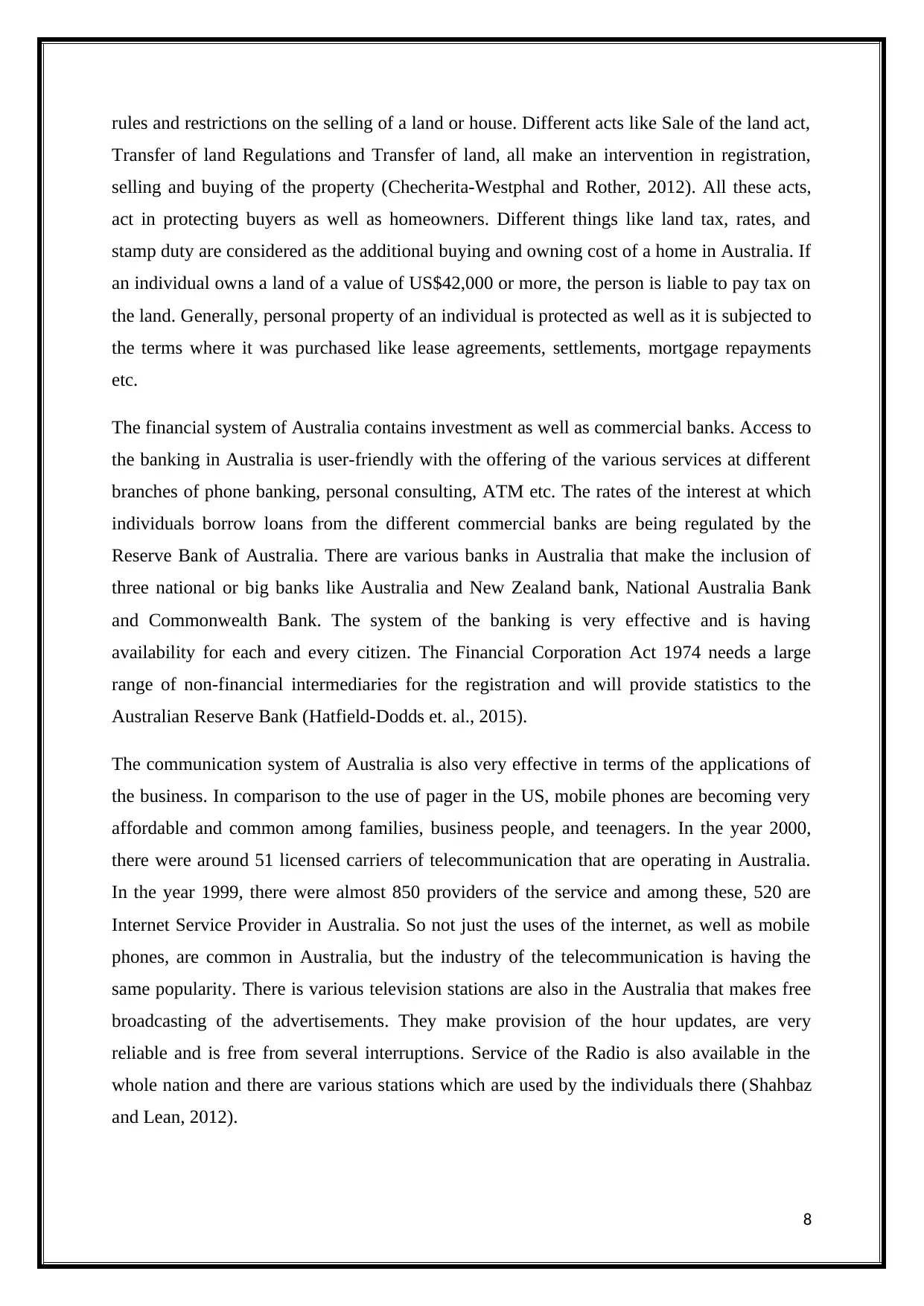
rules and restrictions on the selling of a land or house. Different acts like Sale of the land act,
Transfer of land Regulations and Transfer of land, all make an intervention in registration,
selling and buying of the property (Checherita-Westphal and Rother, 2012). All these acts,
act in protecting buyers as well as homeowners. Different things like land tax, rates, and
stamp duty are considered as the additional buying and owning cost of a home in Australia. If
an individual owns a land of a value of US$42,000 or more, the person is liable to pay tax on
the land. Generally, personal property of an individual is protected as well as it is subjected to
the terms where it was purchased like lease agreements, settlements, mortgage repayments
etc.
The financial system of Australia contains investment as well as commercial banks. Access to
the banking in Australia is user-friendly with the offering of the various services at different
branches of phone banking, personal consulting, ATM etc. The rates of the interest at which
individuals borrow loans from the different commercial banks are being regulated by the
Reserve Bank of Australia. There are various banks in Australia that make the inclusion of
three national or big banks like Australia and New Zealand bank, National Australia Bank
and Commonwealth Bank. The system of the banking is very effective and is having
availability for each and every citizen. The Financial Corporation Act 1974 needs a large
range of non-financial intermediaries for the registration and will provide statistics to the
Australian Reserve Bank (Hatfield-Dodds et. al., 2015).
The communication system of Australia is also very effective in terms of the applications of
the business. In comparison to the use of pager in the US, mobile phones are becoming very
affordable and common among families, business people, and teenagers. In the year 2000,
there were around 51 licensed carriers of telecommunication that are operating in Australia.
In the year 1999, there were almost 850 providers of the service and among these, 520 are
Internet Service Provider in Australia. So not just the uses of the internet, as well as mobile
phones, are common in Australia, but the industry of the telecommunication is having the
same popularity. There is various television stations are also in the Australia that makes free
broadcasting of the advertisements. They make provision of the hour updates, are very
reliable and is free from several interruptions. Service of the Radio is also available in the
whole nation and there are various stations which are used by the individuals there (Shahbaz
and Lean, 2012).
8
Transfer of land Regulations and Transfer of land, all make an intervention in registration,
selling and buying of the property (Checherita-Westphal and Rother, 2012). All these acts,
act in protecting buyers as well as homeowners. Different things like land tax, rates, and
stamp duty are considered as the additional buying and owning cost of a home in Australia. If
an individual owns a land of a value of US$42,000 or more, the person is liable to pay tax on
the land. Generally, personal property of an individual is protected as well as it is subjected to
the terms where it was purchased like lease agreements, settlements, mortgage repayments
etc.
The financial system of Australia contains investment as well as commercial banks. Access to
the banking in Australia is user-friendly with the offering of the various services at different
branches of phone banking, personal consulting, ATM etc. The rates of the interest at which
individuals borrow loans from the different commercial banks are being regulated by the
Reserve Bank of Australia. There are various banks in Australia that make the inclusion of
three national or big banks like Australia and New Zealand bank, National Australia Bank
and Commonwealth Bank. The system of the banking is very effective and is having
availability for each and every citizen. The Financial Corporation Act 1974 needs a large
range of non-financial intermediaries for the registration and will provide statistics to the
Australian Reserve Bank (Hatfield-Dodds et. al., 2015).
The communication system of Australia is also very effective in terms of the applications of
the business. In comparison to the use of pager in the US, mobile phones are becoming very
affordable and common among families, business people, and teenagers. In the year 2000,
there were around 51 licensed carriers of telecommunication that are operating in Australia.
In the year 1999, there were almost 850 providers of the service and among these, 520 are
Internet Service Provider in Australia. So not just the uses of the internet, as well as mobile
phones, are common in Australia, but the industry of the telecommunication is having the
same popularity. There is various television stations are also in the Australia that makes free
broadcasting of the advertisements. They make provision of the hour updates, are very
reliable and is free from several interruptions. Service of the Radio is also available in the
whole nation and there are various stations which are used by the individuals there (Shahbaz
and Lean, 2012).
8
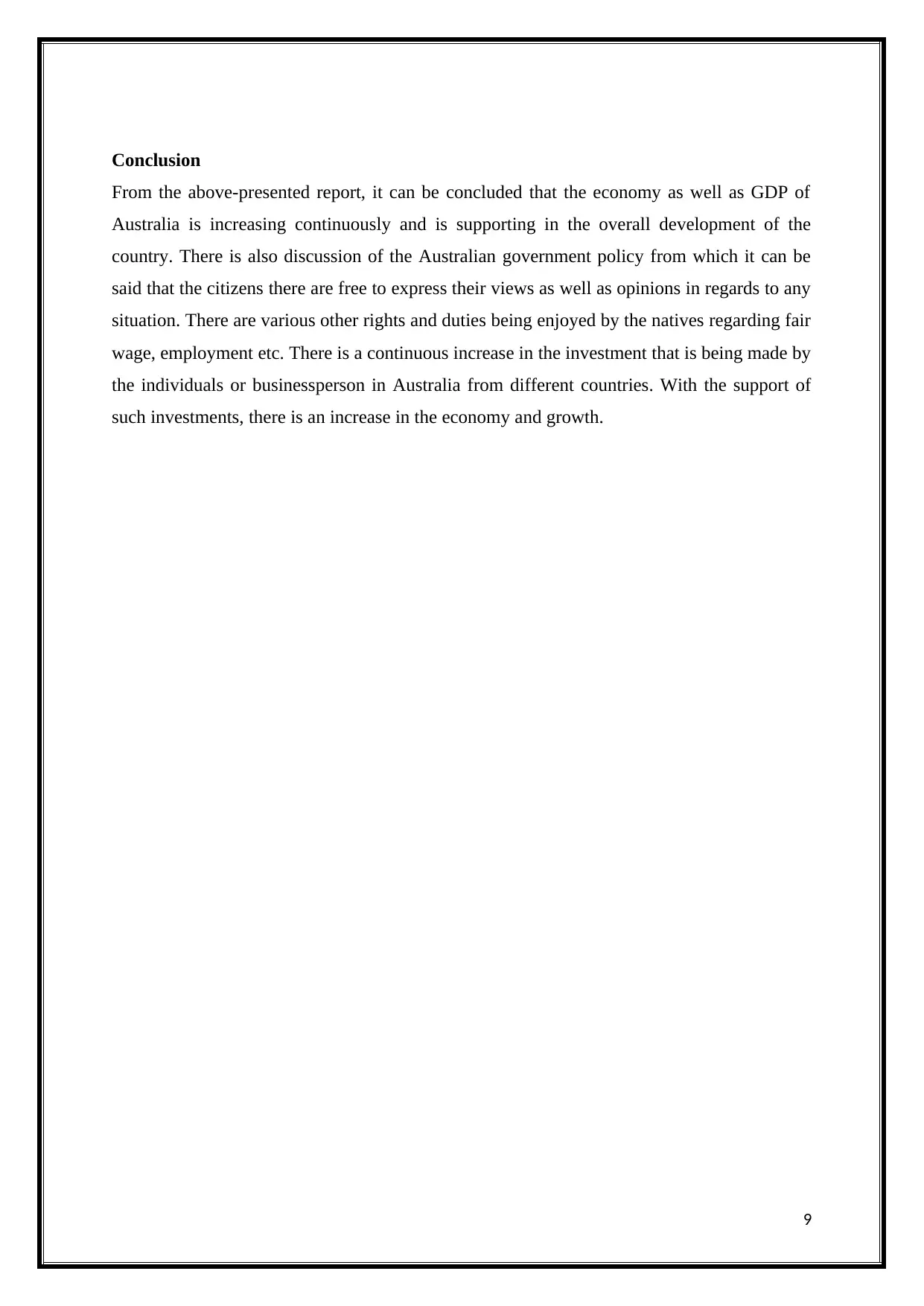
Conclusion
From the above-presented report, it can be concluded that the economy as well as GDP of
Australia is increasing continuously and is supporting in the overall development of the
country. There is also discussion of the Australian government policy from which it can be
said that the citizens there are free to express their views as well as opinions in regards to any
situation. There are various other rights and duties being enjoyed by the natives regarding fair
wage, employment etc. There is a continuous increase in the investment that is being made by
the individuals or businessperson in Australia from different countries. With the support of
such investments, there is an increase in the economy and growth.
9
From the above-presented report, it can be concluded that the economy as well as GDP of
Australia is increasing continuously and is supporting in the overall development of the
country. There is also discussion of the Australian government policy from which it can be
said that the citizens there are free to express their views as well as opinions in regards to any
situation. There are various other rights and duties being enjoyed by the natives regarding fair
wage, employment etc. There is a continuous increase in the investment that is being made by
the individuals or businessperson in Australia from different countries. With the support of
such investments, there is an increase in the economy and growth.
9
⊘ This is a preview!⊘
Do you want full access?
Subscribe today to unlock all pages.

Trusted by 1+ million students worldwide
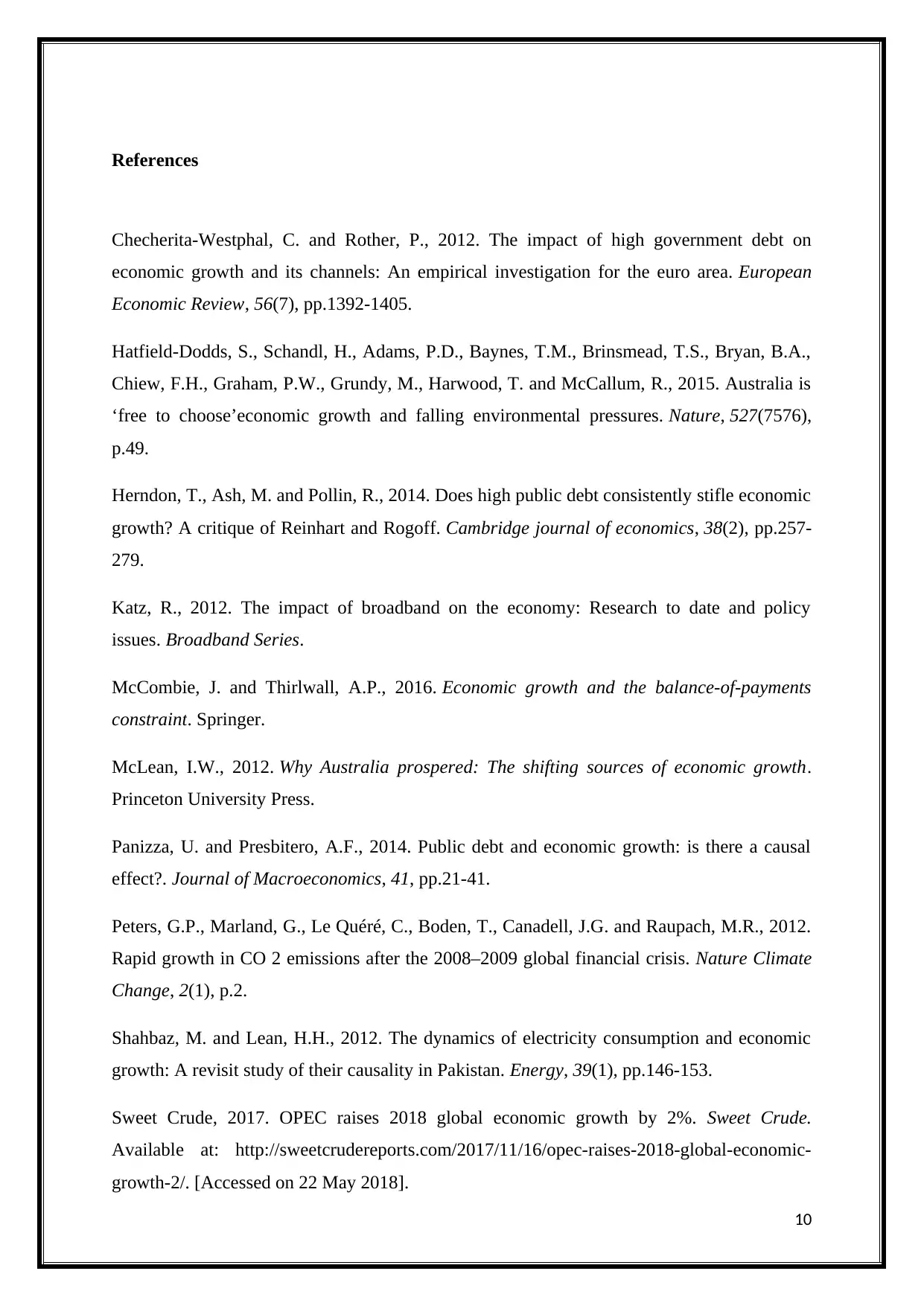
References
Checherita-Westphal, C. and Rother, P., 2012. The impact of high government debt on
economic growth and its channels: An empirical investigation for the euro area. European
Economic Review, 56(7), pp.1392-1405.
Hatfield-Dodds, S., Schandl, H., Adams, P.D., Baynes, T.M., Brinsmead, T.S., Bryan, B.A.,
Chiew, F.H., Graham, P.W., Grundy, M., Harwood, T. and McCallum, R., 2015. Australia is
‘free to choose’economic growth and falling environmental pressures. Nature, 527(7576),
p.49.
Herndon, T., Ash, M. and Pollin, R., 2014. Does high public debt consistently stifle economic
growth? A critique of Reinhart and Rogoff. Cambridge journal of economics, 38(2), pp.257-
279.
Katz, R., 2012. The impact of broadband on the economy: Research to date and policy
issues. Broadband Series.
McCombie, J. and Thirlwall, A.P., 2016. Economic growth and the balance-of-payments
constraint. Springer.
McLean, I.W., 2012. Why Australia prospered: The shifting sources of economic growth.
Princeton University Press.
Panizza, U. and Presbitero, A.F., 2014. Public debt and economic growth: is there a causal
effect?. Journal of Macroeconomics, 41, pp.21-41.
Peters, G.P., Marland, G., Le Quéré, C., Boden, T., Canadell, J.G. and Raupach, M.R., 2012.
Rapid growth in CO 2 emissions after the 2008–2009 global financial crisis. Nature Climate
Change, 2(1), p.2.
Shahbaz, M. and Lean, H.H., 2012. The dynamics of electricity consumption and economic
growth: A revisit study of their causality in Pakistan. Energy, 39(1), pp.146-153.
Sweet Crude, 2017. OPEC raises 2018 global economic growth by 2%. Sweet Crude.
Available at: http://sweetcrudereports.com/2017/11/16/opec-raises-2018-global-economic-
growth-2/. [Accessed on 22 May 2018].
10
Checherita-Westphal, C. and Rother, P., 2012. The impact of high government debt on
economic growth and its channels: An empirical investigation for the euro area. European
Economic Review, 56(7), pp.1392-1405.
Hatfield-Dodds, S., Schandl, H., Adams, P.D., Baynes, T.M., Brinsmead, T.S., Bryan, B.A.,
Chiew, F.H., Graham, P.W., Grundy, M., Harwood, T. and McCallum, R., 2015. Australia is
‘free to choose’economic growth and falling environmental pressures. Nature, 527(7576),
p.49.
Herndon, T., Ash, M. and Pollin, R., 2014. Does high public debt consistently stifle economic
growth? A critique of Reinhart and Rogoff. Cambridge journal of economics, 38(2), pp.257-
279.
Katz, R., 2012. The impact of broadband on the economy: Research to date and policy
issues. Broadband Series.
McCombie, J. and Thirlwall, A.P., 2016. Economic growth and the balance-of-payments
constraint. Springer.
McLean, I.W., 2012. Why Australia prospered: The shifting sources of economic growth.
Princeton University Press.
Panizza, U. and Presbitero, A.F., 2014. Public debt and economic growth: is there a causal
effect?. Journal of Macroeconomics, 41, pp.21-41.
Peters, G.P., Marland, G., Le Quéré, C., Boden, T., Canadell, J.G. and Raupach, M.R., 2012.
Rapid growth in CO 2 emissions after the 2008–2009 global financial crisis. Nature Climate
Change, 2(1), p.2.
Shahbaz, M. and Lean, H.H., 2012. The dynamics of electricity consumption and economic
growth: A revisit study of their causality in Pakistan. Energy, 39(1), pp.146-153.
Sweet Crude, 2017. OPEC raises 2018 global economic growth by 2%. Sweet Crude.
Available at: http://sweetcrudereports.com/2017/11/16/opec-raises-2018-global-economic-
growth-2/. [Accessed on 22 May 2018].
10
Paraphrase This Document
Need a fresh take? Get an instant paraphrase of this document with our AI Paraphraser

Trading Economics, 2018. Australia GDP Growth Rate. [Online]. Trading Economics.
Available at: https://tradingeconomics.com/australia/gdp-growth. [Accessed on 22 May
2018].
11
Available at: https://tradingeconomics.com/australia/gdp-growth. [Accessed on 22 May
2018].
11
1 out of 11
Related Documents
Your All-in-One AI-Powered Toolkit for Academic Success.
+13062052269
info@desklib.com
Available 24*7 on WhatsApp / Email
![[object Object]](/_next/static/media/star-bottom.7253800d.svg)
Unlock your academic potential
Copyright © 2020–2025 A2Z Services. All Rights Reserved. Developed and managed by ZUCOL.





